Marketing in Travel and Tourism: Consumer Behavior and Strategies
VerifiedAdded on 2023/03/29
|13
|3495
|245
Report
AI Summary
This report provides a comprehensive overview of marketing principles within the travel and tourism sector. It begins by exploring core marketing concepts, including consumer needs, marketing offers, and the importance of customer value and satisfaction. The report then examines the impact of the marketing environment, both micro and macro, on individual travel and tourism businesses, with a specific focus on factors affecting consumer motivation and demand. It delves into market segmentation, strategic marketing planning (including SWOT analysis of Thomas Cook), and the significance of marketing research. The analysis extends to the product, price, and place elements of the marketing mix, as well as the importance of service sector mix elements and the concept of the total tourism product. Finally, the report assesses the integrated nature and role of the promotional mix, advocating for a well-justified integrated promotional campaign within the travel and tourism industry.
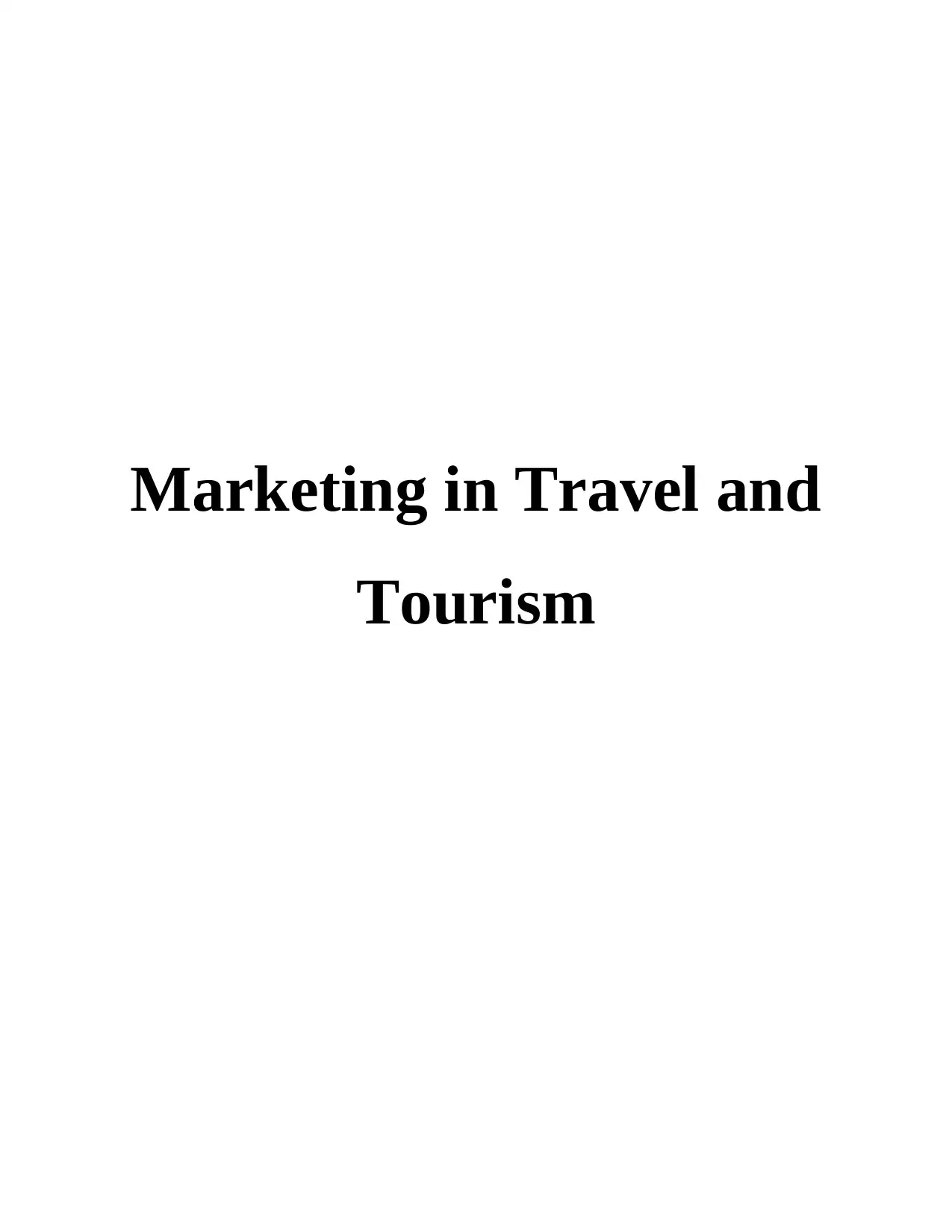
Marketing in Travel and
Tourism
Tourism
Paraphrase This Document
Need a fresh take? Get an instant paraphrase of this document with our AI Paraphraser
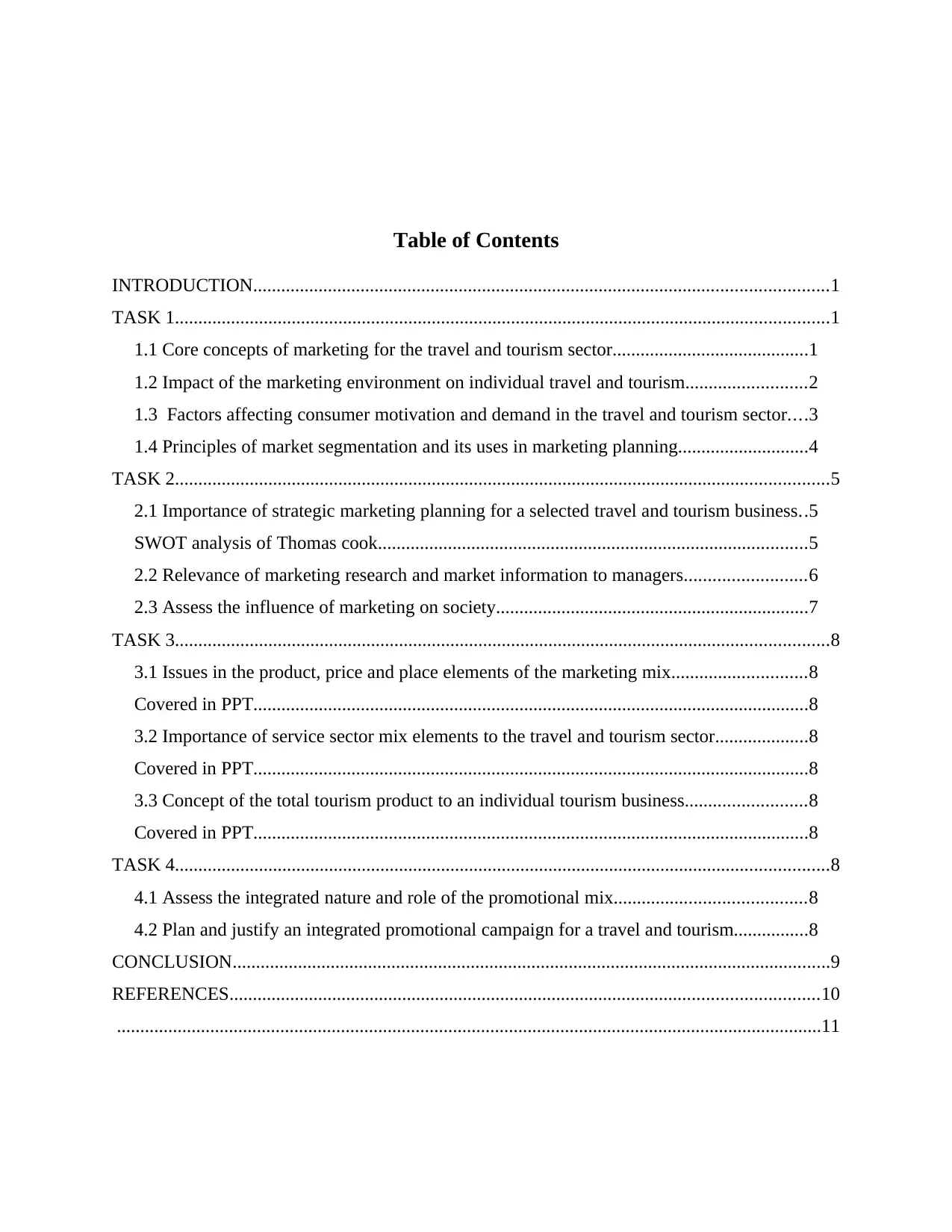
Table of Contents
INTRODUCTION...........................................................................................................................1
TASK 1............................................................................................................................................1
1.1 Core concepts of marketing for the travel and tourism sector..........................................1
1.2 Impact of the marketing environment on individual travel and tourism..........................2
1.3 Factors affecting consumer motivation and demand in the travel and tourism sector....3
1.4 Principles of market segmentation and its uses in marketing planning............................4
TASK 2............................................................................................................................................5
2.1 Importance of strategic marketing planning for a selected travel and tourism business..5
SWOT analysis of Thomas cook............................................................................................5
2.2 Relevance of marketing research and market information to managers..........................6
2.3 Assess the influence of marketing on society...................................................................7
TASK 3............................................................................................................................................8
3.1 Issues in the product, price and place elements of the marketing mix.............................8
Covered in PPT.......................................................................................................................8
3.2 Importance of service sector mix elements to the travel and tourism sector....................8
Covered in PPT.......................................................................................................................8
3.3 Concept of the total tourism product to an individual tourism business..........................8
Covered in PPT.......................................................................................................................8
TASK 4............................................................................................................................................8
4.1 Assess the integrated nature and role of the promotional mix.........................................8
4.2 Plan and justify an integrated promotional campaign for a travel and tourism................8
CONCLUSION................................................................................................................................9
REFERENCES..............................................................................................................................10
.......................................................................................................................................................11
INTRODUCTION...........................................................................................................................1
TASK 1............................................................................................................................................1
1.1 Core concepts of marketing for the travel and tourism sector..........................................1
1.2 Impact of the marketing environment on individual travel and tourism..........................2
1.3 Factors affecting consumer motivation and demand in the travel and tourism sector....3
1.4 Principles of market segmentation and its uses in marketing planning............................4
TASK 2............................................................................................................................................5
2.1 Importance of strategic marketing planning for a selected travel and tourism business..5
SWOT analysis of Thomas cook............................................................................................5
2.2 Relevance of marketing research and market information to managers..........................6
2.3 Assess the influence of marketing on society...................................................................7
TASK 3............................................................................................................................................8
3.1 Issues in the product, price and place elements of the marketing mix.............................8
Covered in PPT.......................................................................................................................8
3.2 Importance of service sector mix elements to the travel and tourism sector....................8
Covered in PPT.......................................................................................................................8
3.3 Concept of the total tourism product to an individual tourism business..........................8
Covered in PPT.......................................................................................................................8
TASK 4............................................................................................................................................8
4.1 Assess the integrated nature and role of the promotional mix.........................................8
4.2 Plan and justify an integrated promotional campaign for a travel and tourism................8
CONCLUSION................................................................................................................................9
REFERENCES..............................................................................................................................10
.......................................................................................................................................................11
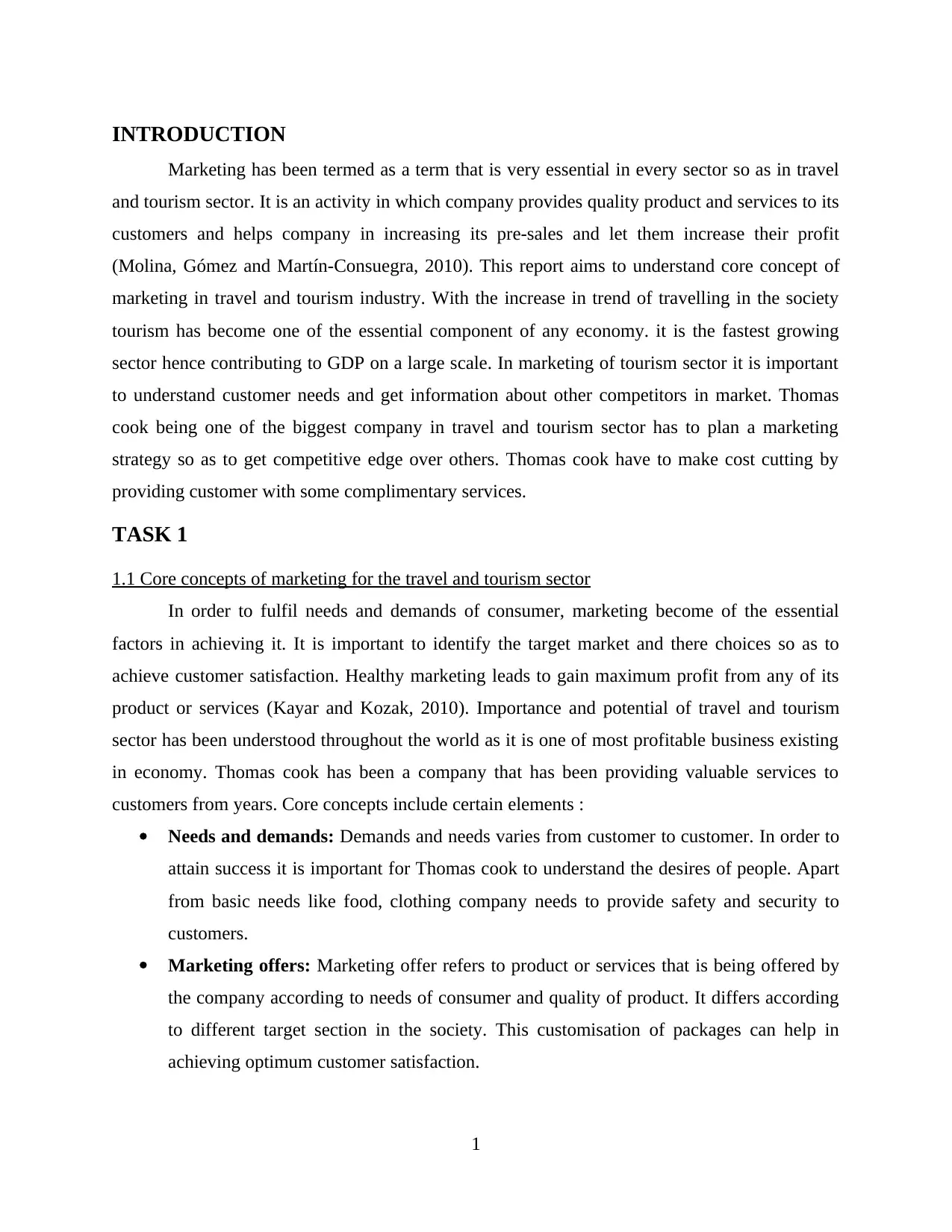
INTRODUCTION
Marketing has been termed as a term that is very essential in every sector so as in travel
and tourism sector. It is an activity in which company provides quality product and services to its
customers and helps company in increasing its pre-sales and let them increase their profit
(Molina, Gómez and Martín-Consuegra, 2010). This report aims to understand core concept of
marketing in travel and tourism industry. With the increase in trend of travelling in the society
tourism has become one of the essential component of any economy. it is the fastest growing
sector hence contributing to GDP on a large scale. In marketing of tourism sector it is important
to understand customer needs and get information about other competitors in market. Thomas
cook being one of the biggest company in travel and tourism sector has to plan a marketing
strategy so as to get competitive edge over others. Thomas cook have to make cost cutting by
providing customer with some complimentary services.
TASK 1
1.1 Core concepts of marketing for the travel and tourism sector
In order to fulfil needs and demands of consumer, marketing become of the essential
factors in achieving it. It is important to identify the target market and there choices so as to
achieve customer satisfaction. Healthy marketing leads to gain maximum profit from any of its
product or services (Kayar and Kozak, 2010). Importance and potential of travel and tourism
sector has been understood throughout the world as it is one of most profitable business existing
in economy. Thomas cook has been a company that has been providing valuable services to
customers from years. Core concepts include certain elements :
Needs and demands: Demands and needs varies from customer to customer. In order to
attain success it is important for Thomas cook to understand the desires of people. Apart
from basic needs like food, clothing company needs to provide safety and security to
customers.
Marketing offers: Marketing offer refers to product or services that is being offered by
the company according to needs of consumer and quality of product. It differs according
to different target section in the society. This customisation of packages can help in
achieving optimum customer satisfaction.
1
Marketing has been termed as a term that is very essential in every sector so as in travel
and tourism sector. It is an activity in which company provides quality product and services to its
customers and helps company in increasing its pre-sales and let them increase their profit
(Molina, Gómez and Martín-Consuegra, 2010). This report aims to understand core concept of
marketing in travel and tourism industry. With the increase in trend of travelling in the society
tourism has become one of the essential component of any economy. it is the fastest growing
sector hence contributing to GDP on a large scale. In marketing of tourism sector it is important
to understand customer needs and get information about other competitors in market. Thomas
cook being one of the biggest company in travel and tourism sector has to plan a marketing
strategy so as to get competitive edge over others. Thomas cook have to make cost cutting by
providing customer with some complimentary services.
TASK 1
1.1 Core concepts of marketing for the travel and tourism sector
In order to fulfil needs and demands of consumer, marketing become of the essential
factors in achieving it. It is important to identify the target market and there choices so as to
achieve customer satisfaction. Healthy marketing leads to gain maximum profit from any of its
product or services (Kayar and Kozak, 2010). Importance and potential of travel and tourism
sector has been understood throughout the world as it is one of most profitable business existing
in economy. Thomas cook has been a company that has been providing valuable services to
customers from years. Core concepts include certain elements :
Needs and demands: Demands and needs varies from customer to customer. In order to
attain success it is important for Thomas cook to understand the desires of people. Apart
from basic needs like food, clothing company needs to provide safety and security to
customers.
Marketing offers: Marketing offer refers to product or services that is being offered by
the company according to needs of consumer and quality of product. It differs according
to different target section in the society. This customisation of packages can help in
achieving optimum customer satisfaction.
1
⊘ This is a preview!⊘
Do you want full access?
Subscribe today to unlock all pages.

Trusted by 1+ million students worldwide
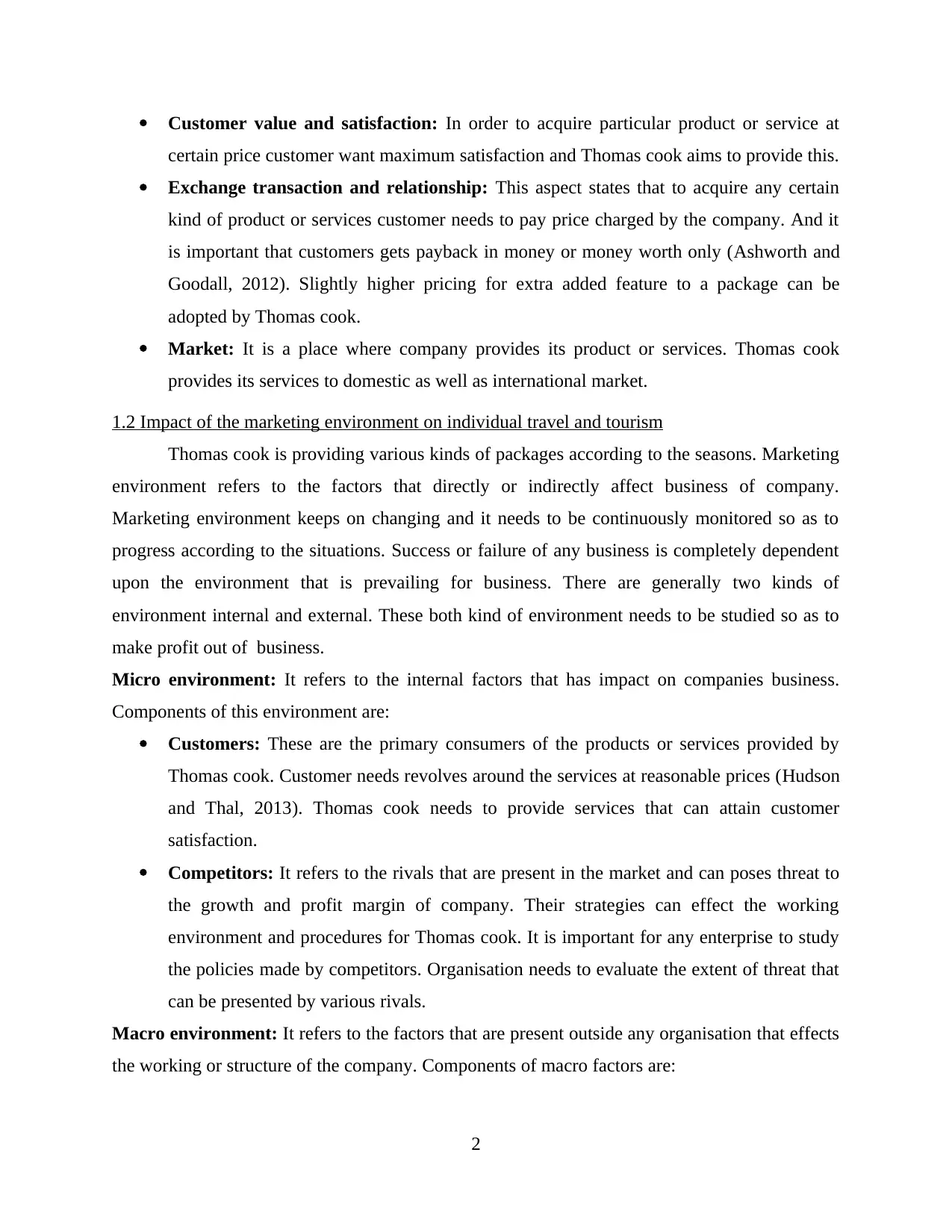
Customer value and satisfaction: In order to acquire particular product or service at
certain price customer want maximum satisfaction and Thomas cook aims to provide this.
Exchange transaction and relationship: This aspect states that to acquire any certain
kind of product or services customer needs to pay price charged by the company. And it
is important that customers gets payback in money or money worth only (Ashworth and
Goodall, 2012). Slightly higher pricing for extra added feature to a package can be
adopted by Thomas cook.
Market: It is a place where company provides its product or services. Thomas cook
provides its services to domestic as well as international market.
1.2 Impact of the marketing environment on individual travel and tourism
Thomas cook is providing various kinds of packages according to the seasons. Marketing
environment refers to the factors that directly or indirectly affect business of company.
Marketing environment keeps on changing and it needs to be continuously monitored so as to
progress according to the situations. Success or failure of any business is completely dependent
upon the environment that is prevailing for business. There are generally two kinds of
environment internal and external. These both kind of environment needs to be studied so as to
make profit out of business.
Micro environment: It refers to the internal factors that has impact on companies business.
Components of this environment are:
Customers: These are the primary consumers of the products or services provided by
Thomas cook. Customer needs revolves around the services at reasonable prices (Hudson
and Thal, 2013). Thomas cook needs to provide services that can attain customer
satisfaction.
Competitors: It refers to the rivals that are present in the market and can poses threat to
the growth and profit margin of company. Their strategies can effect the working
environment and procedures for Thomas cook. It is important for any enterprise to study
the policies made by competitors. Organisation needs to evaluate the extent of threat that
can be presented by various rivals.
Macro environment: It refers to the factors that are present outside any organisation that effects
the working or structure of the company. Components of macro factors are:
2
certain price customer want maximum satisfaction and Thomas cook aims to provide this.
Exchange transaction and relationship: This aspect states that to acquire any certain
kind of product or services customer needs to pay price charged by the company. And it
is important that customers gets payback in money or money worth only (Ashworth and
Goodall, 2012). Slightly higher pricing for extra added feature to a package can be
adopted by Thomas cook.
Market: It is a place where company provides its product or services. Thomas cook
provides its services to domestic as well as international market.
1.2 Impact of the marketing environment on individual travel and tourism
Thomas cook is providing various kinds of packages according to the seasons. Marketing
environment refers to the factors that directly or indirectly affect business of company.
Marketing environment keeps on changing and it needs to be continuously monitored so as to
progress according to the situations. Success or failure of any business is completely dependent
upon the environment that is prevailing for business. There are generally two kinds of
environment internal and external. These both kind of environment needs to be studied so as to
make profit out of business.
Micro environment: It refers to the internal factors that has impact on companies business.
Components of this environment are:
Customers: These are the primary consumers of the products or services provided by
Thomas cook. Customer needs revolves around the services at reasonable prices (Hudson
and Thal, 2013). Thomas cook needs to provide services that can attain customer
satisfaction.
Competitors: It refers to the rivals that are present in the market and can poses threat to
the growth and profit margin of company. Their strategies can effect the working
environment and procedures for Thomas cook. It is important for any enterprise to study
the policies made by competitors. Organisation needs to evaluate the extent of threat that
can be presented by various rivals.
Macro environment: It refers to the factors that are present outside any organisation that effects
the working or structure of the company. Components of macro factors are:
2
Paraphrase This Document
Need a fresh take? Get an instant paraphrase of this document with our AI Paraphraser
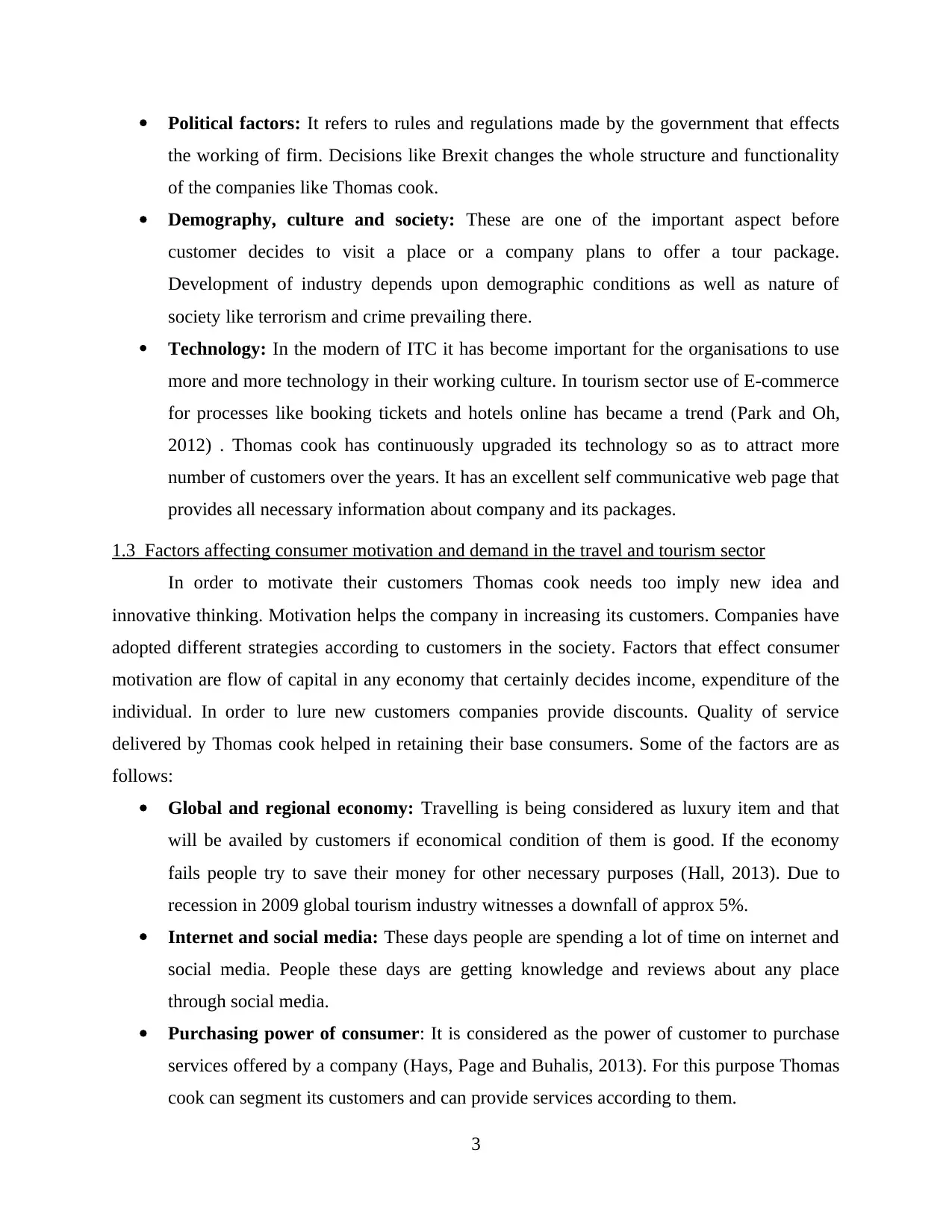
Political factors: It refers to rules and regulations made by the government that effects
the working of firm. Decisions like Brexit changes the whole structure and functionality
of the companies like Thomas cook.
Demography, culture and society: These are one of the important aspect before
customer decides to visit a place or a company plans to offer a tour package.
Development of industry depends upon demographic conditions as well as nature of
society like terrorism and crime prevailing there.
Technology: In the modern of ITC it has become important for the organisations to use
more and more technology in their working culture. In tourism sector use of E-commerce
for processes like booking tickets and hotels online has became a trend (Park and Oh,
2012) . Thomas cook has continuously upgraded its technology so as to attract more
number of customers over the years. It has an excellent self communicative web page that
provides all necessary information about company and its packages.
1.3 Factors affecting consumer motivation and demand in the travel and tourism sector
In order to motivate their customers Thomas cook needs too imply new idea and
innovative thinking. Motivation helps the company in increasing its customers. Companies have
adopted different strategies according to customers in the society. Factors that effect consumer
motivation are flow of capital in any economy that certainly decides income, expenditure of the
individual. In order to lure new customers companies provide discounts. Quality of service
delivered by Thomas cook helped in retaining their base consumers. Some of the factors are as
follows:
Global and regional economy: Travelling is being considered as luxury item and that
will be availed by customers if economical condition of them is good. If the economy
fails people try to save their money for other necessary purposes (Hall, 2013). Due to
recession in 2009 global tourism industry witnesses a downfall of approx 5%.
Internet and social media: These days people are spending a lot of time on internet and
social media. People these days are getting knowledge and reviews about any place
through social media.
Purchasing power of consumer: It is considered as the power of customer to purchase
services offered by a company (Hays, Page and Buhalis, 2013). For this purpose Thomas
cook can segment its customers and can provide services according to them.
3
the working of firm. Decisions like Brexit changes the whole structure and functionality
of the companies like Thomas cook.
Demography, culture and society: These are one of the important aspect before
customer decides to visit a place or a company plans to offer a tour package.
Development of industry depends upon demographic conditions as well as nature of
society like terrorism and crime prevailing there.
Technology: In the modern of ITC it has become important for the organisations to use
more and more technology in their working culture. In tourism sector use of E-commerce
for processes like booking tickets and hotels online has became a trend (Park and Oh,
2012) . Thomas cook has continuously upgraded its technology so as to attract more
number of customers over the years. It has an excellent self communicative web page that
provides all necessary information about company and its packages.
1.3 Factors affecting consumer motivation and demand in the travel and tourism sector
In order to motivate their customers Thomas cook needs too imply new idea and
innovative thinking. Motivation helps the company in increasing its customers. Companies have
adopted different strategies according to customers in the society. Factors that effect consumer
motivation are flow of capital in any economy that certainly decides income, expenditure of the
individual. In order to lure new customers companies provide discounts. Quality of service
delivered by Thomas cook helped in retaining their base consumers. Some of the factors are as
follows:
Global and regional economy: Travelling is being considered as luxury item and that
will be availed by customers if economical condition of them is good. If the economy
fails people try to save their money for other necessary purposes (Hall, 2013). Due to
recession in 2009 global tourism industry witnesses a downfall of approx 5%.
Internet and social media: These days people are spending a lot of time on internet and
social media. People these days are getting knowledge and reviews about any place
through social media.
Purchasing power of consumer: It is considered as the power of customer to purchase
services offered by a company (Hays, Page and Buhalis, 2013). For this purpose Thomas
cook can segment its customers and can provide services according to them.
3
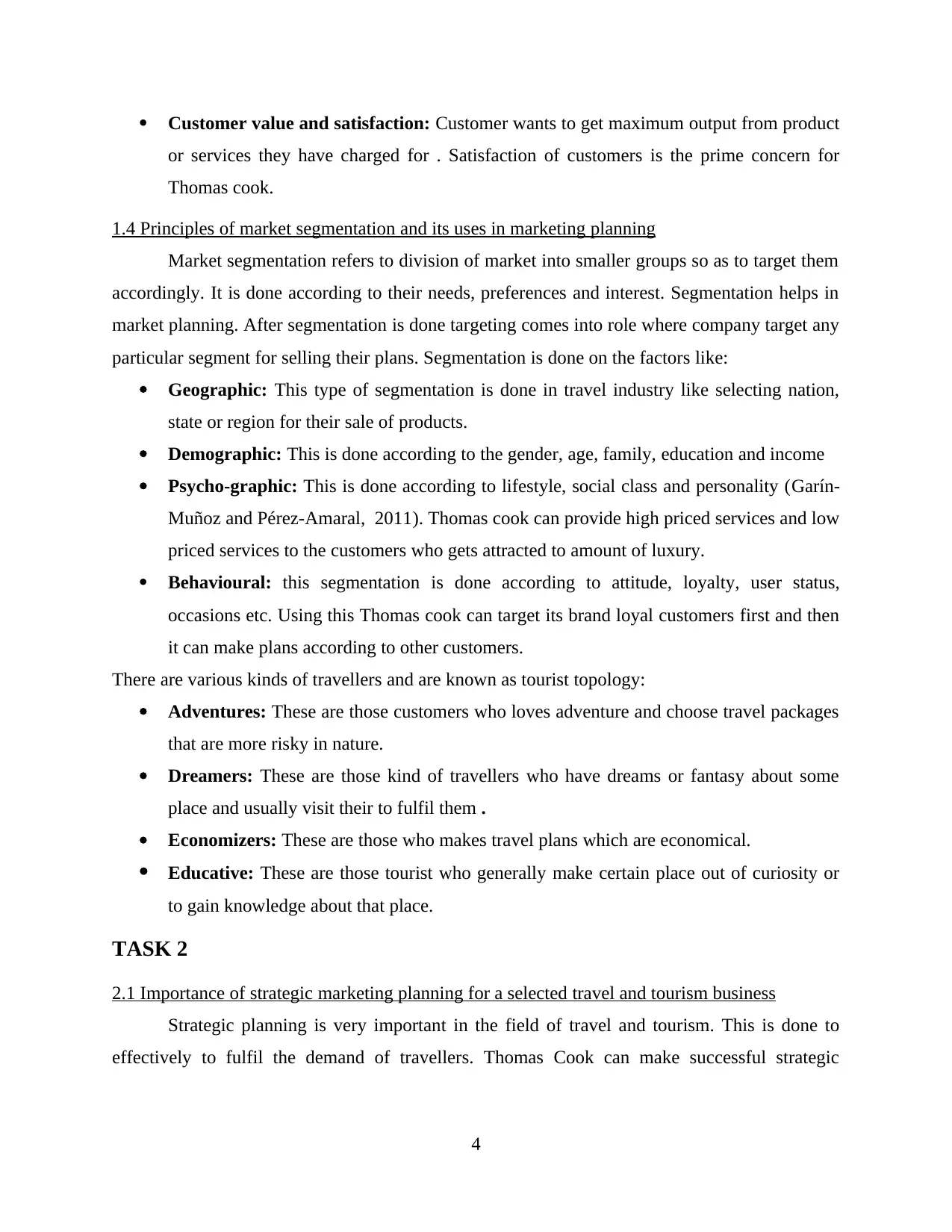
Customer value and satisfaction: Customer wants to get maximum output from product
or services they have charged for . Satisfaction of customers is the prime concern for
Thomas cook.
1.4 Principles of market segmentation and its uses in marketing planning
Market segmentation refers to division of market into smaller groups so as to target them
accordingly. It is done according to their needs, preferences and interest. Segmentation helps in
market planning. After segmentation is done targeting comes into role where company target any
particular segment for selling their plans. Segmentation is done on the factors like:
Geographic: This type of segmentation is done in travel industry like selecting nation,
state or region for their sale of products.
Demographic: This is done according to the gender, age, family, education and income
Psycho-graphic: This is done according to lifestyle, social class and personality (Garín-
Muñoz and Pérez-Amaral, 2011). Thomas cook can provide high priced services and low
priced services to the customers who gets attracted to amount of luxury.
Behavioural: this segmentation is done according to attitude, loyalty, user status,
occasions etc. Using this Thomas cook can target its brand loyal customers first and then
it can make plans according to other customers.
There are various kinds of travellers and are known as tourist topology:
Adventures: These are those customers who loves adventure and choose travel packages
that are more risky in nature.
Dreamers: These are those kind of travellers who have dreams or fantasy about some
place and usually visit their to fulfil them .
Economizers: These are those who makes travel plans which are economical.
Educative: These are those tourist who generally make certain place out of curiosity or
to gain knowledge about that place.
TASK 2
2.1 Importance of strategic marketing planning for a selected travel and tourism business
Strategic planning is very important in the field of travel and tourism. This is done to
effectively to fulfil the demand of travellers. Thomas Cook can make successful strategic
4
or services they have charged for . Satisfaction of customers is the prime concern for
Thomas cook.
1.4 Principles of market segmentation and its uses in marketing planning
Market segmentation refers to division of market into smaller groups so as to target them
accordingly. It is done according to their needs, preferences and interest. Segmentation helps in
market planning. After segmentation is done targeting comes into role where company target any
particular segment for selling their plans. Segmentation is done on the factors like:
Geographic: This type of segmentation is done in travel industry like selecting nation,
state or region for their sale of products.
Demographic: This is done according to the gender, age, family, education and income
Psycho-graphic: This is done according to lifestyle, social class and personality (Garín-
Muñoz and Pérez-Amaral, 2011). Thomas cook can provide high priced services and low
priced services to the customers who gets attracted to amount of luxury.
Behavioural: this segmentation is done according to attitude, loyalty, user status,
occasions etc. Using this Thomas cook can target its brand loyal customers first and then
it can make plans according to other customers.
There are various kinds of travellers and are known as tourist topology:
Adventures: These are those customers who loves adventure and choose travel packages
that are more risky in nature.
Dreamers: These are those kind of travellers who have dreams or fantasy about some
place and usually visit their to fulfil them .
Economizers: These are those who makes travel plans which are economical.
Educative: These are those tourist who generally make certain place out of curiosity or
to gain knowledge about that place.
TASK 2
2.1 Importance of strategic marketing planning for a selected travel and tourism business
Strategic planning is very important in the field of travel and tourism. This is done to
effectively to fulfil the demand of travellers. Thomas Cook can make successful strategic
4
⊘ This is a preview!⊘
Do you want full access?
Subscribe today to unlock all pages.

Trusted by 1+ million students worldwide
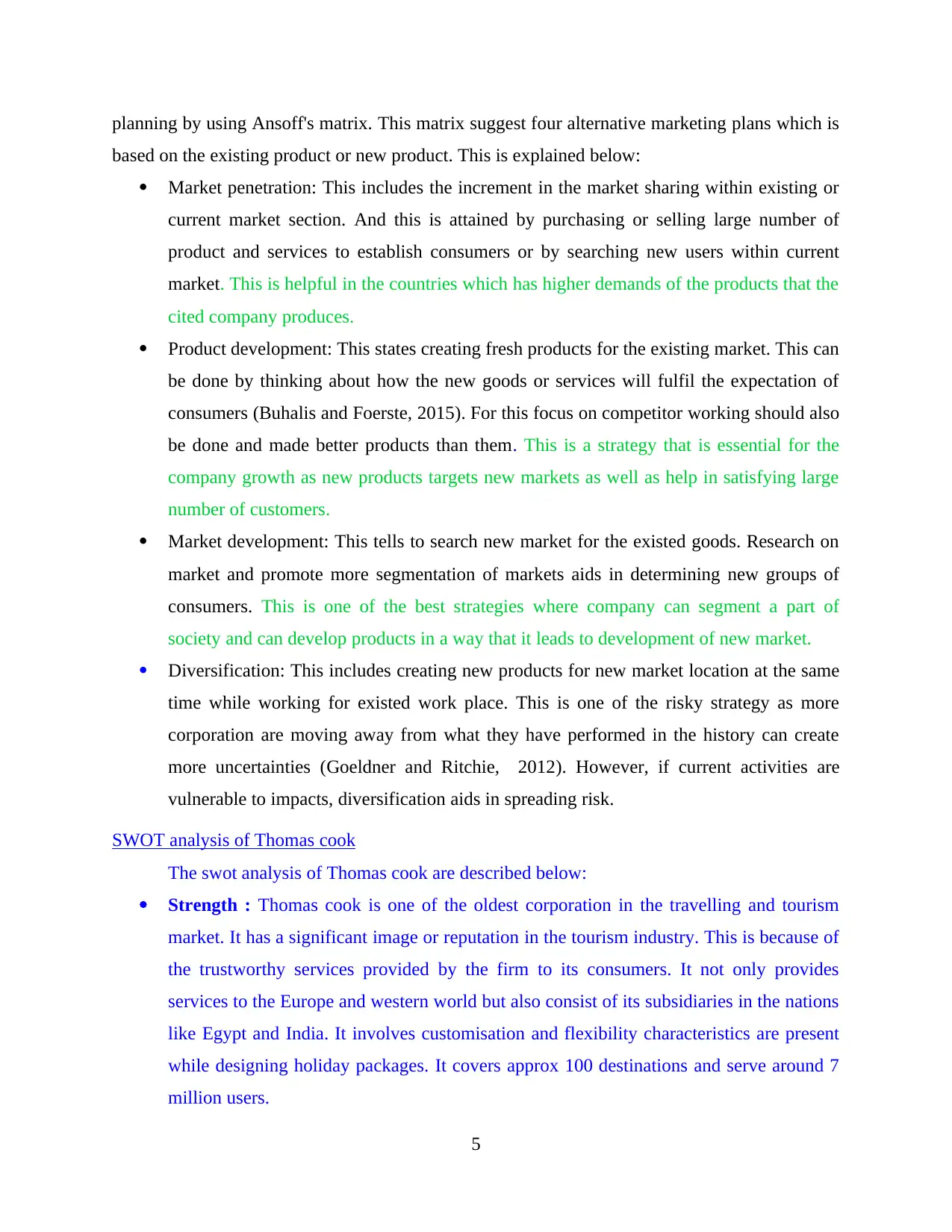
planning by using Ansoff's matrix. This matrix suggest four alternative marketing plans which is
based on the existing product or new product. This is explained below:
Market penetration: This includes the increment in the market sharing within existing or
current market section. And this is attained by purchasing or selling large number of
product and services to establish consumers or by searching new users within current
market. This is helpful in the countries which has higher demands of the products that the
cited company produces.
Product development: This states creating fresh products for the existing market. This can
be done by thinking about how the new goods or services will fulfil the expectation of
consumers (Buhalis and Foerste, 2015). For this focus on competitor working should also
be done and made better products than them. This is a strategy that is essential for the
company growth as new products targets new markets as well as help in satisfying large
number of customers.
Market development: This tells to search new market for the existed goods. Research on
market and promote more segmentation of markets aids in determining new groups of
consumers. This is one of the best strategies where company can segment a part of
society and can develop products in a way that it leads to development of new market.
Diversification: This includes creating new products for new market location at the same
time while working for existed work place. This is one of the risky strategy as more
corporation are moving away from what they have performed in the history can create
more uncertainties (Goeldner and Ritchie, 2012). However, if current activities are
vulnerable to impacts, diversification aids in spreading risk.
SWOT analysis of Thomas cook
The swot analysis of Thomas cook are described below:
Strength : Thomas cook is one of the oldest corporation in the travelling and tourism
market. It has a significant image or reputation in the tourism industry. This is because of
the trustworthy services provided by the firm to its consumers. It not only provides
services to the Europe and western world but also consist of its subsidiaries in the nations
like Egypt and India. It involves customisation and flexibility characteristics are present
while designing holiday packages. It covers approx 100 destinations and serve around 7
million users.
5
based on the existing product or new product. This is explained below:
Market penetration: This includes the increment in the market sharing within existing or
current market section. And this is attained by purchasing or selling large number of
product and services to establish consumers or by searching new users within current
market. This is helpful in the countries which has higher demands of the products that the
cited company produces.
Product development: This states creating fresh products for the existing market. This can
be done by thinking about how the new goods or services will fulfil the expectation of
consumers (Buhalis and Foerste, 2015). For this focus on competitor working should also
be done and made better products than them. This is a strategy that is essential for the
company growth as new products targets new markets as well as help in satisfying large
number of customers.
Market development: This tells to search new market for the existed goods. Research on
market and promote more segmentation of markets aids in determining new groups of
consumers. This is one of the best strategies where company can segment a part of
society and can develop products in a way that it leads to development of new market.
Diversification: This includes creating new products for new market location at the same
time while working for existed work place. This is one of the risky strategy as more
corporation are moving away from what they have performed in the history can create
more uncertainties (Goeldner and Ritchie, 2012). However, if current activities are
vulnerable to impacts, diversification aids in spreading risk.
SWOT analysis of Thomas cook
The swot analysis of Thomas cook are described below:
Strength : Thomas cook is one of the oldest corporation in the travelling and tourism
market. It has a significant image or reputation in the tourism industry. This is because of
the trustworthy services provided by the firm to its consumers. It not only provides
services to the Europe and western world but also consist of its subsidiaries in the nations
like Egypt and India. It involves customisation and flexibility characteristics are present
while designing holiday packages. It covers approx 100 destinations and serve around 7
million users.
5
Paraphrase This Document
Need a fresh take? Get an instant paraphrase of this document with our AI Paraphraser
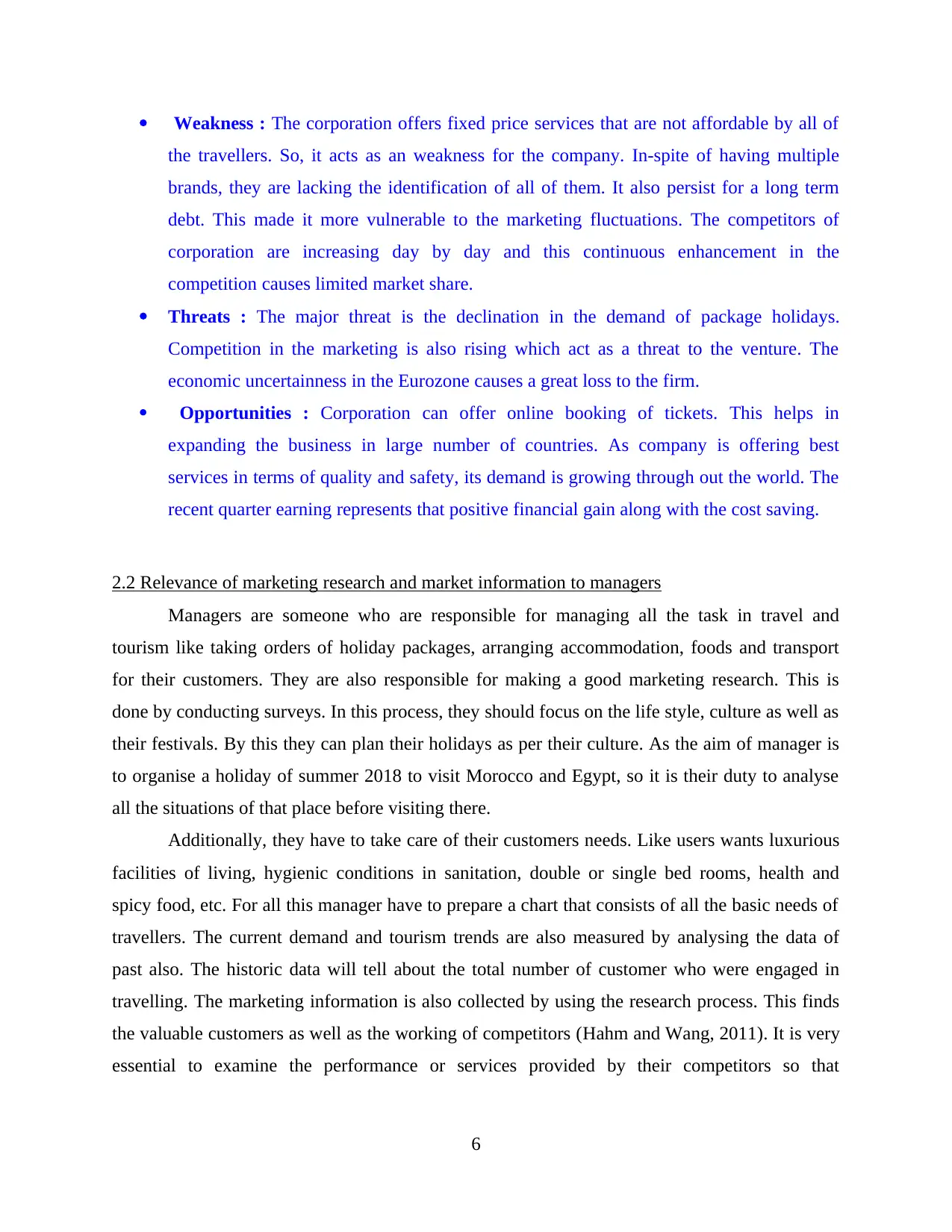
Weakness : The corporation offers fixed price services that are not affordable by all of
the travellers. So, it acts as an weakness for the company. In-spite of having multiple
brands, they are lacking the identification of all of them. It also persist for a long term
debt. This made it more vulnerable to the marketing fluctuations. The competitors of
corporation are increasing day by day and this continuous enhancement in the
competition causes limited market share.
Threats : The major threat is the declination in the demand of package holidays.
Competition in the marketing is also rising which act as a threat to the venture. The
economic uncertainness in the Eurozone causes a great loss to the firm.
Opportunities : Corporation can offer online booking of tickets. This helps in
expanding the business in large number of countries. As company is offering best
services in terms of quality and safety, its demand is growing through out the world. The
recent quarter earning represents that positive financial gain along with the cost saving.
2.2 Relevance of marketing research and market information to managers
Managers are someone who are responsible for managing all the task in travel and
tourism like taking orders of holiday packages, arranging accommodation, foods and transport
for their customers. They are also responsible for making a good marketing research. This is
done by conducting surveys. In this process, they should focus on the life style, culture as well as
their festivals. By this they can plan their holidays as per their culture. As the aim of manager is
to organise a holiday of summer 2018 to visit Morocco and Egypt, so it is their duty to analyse
all the situations of that place before visiting there.
Additionally, they have to take care of their customers needs. Like users wants luxurious
facilities of living, hygienic conditions in sanitation, double or single bed rooms, health and
spicy food, etc. For all this manager have to prepare a chart that consists of all the basic needs of
travellers. The current demand and tourism trends are also measured by analysing the data of
past also. The historic data will tell about the total number of customer who were engaged in
travelling. The marketing information is also collected by using the research process. This finds
the valuable customers as well as the working of competitors (Hahm and Wang, 2011). It is very
essential to examine the performance or services provided by their competitors so that
6
the travellers. So, it acts as an weakness for the company. In-spite of having multiple
brands, they are lacking the identification of all of them. It also persist for a long term
debt. This made it more vulnerable to the marketing fluctuations. The competitors of
corporation are increasing day by day and this continuous enhancement in the
competition causes limited market share.
Threats : The major threat is the declination in the demand of package holidays.
Competition in the marketing is also rising which act as a threat to the venture. The
economic uncertainness in the Eurozone causes a great loss to the firm.
Opportunities : Corporation can offer online booking of tickets. This helps in
expanding the business in large number of countries. As company is offering best
services in terms of quality and safety, its demand is growing through out the world. The
recent quarter earning represents that positive financial gain along with the cost saving.
2.2 Relevance of marketing research and market information to managers
Managers are someone who are responsible for managing all the task in travel and
tourism like taking orders of holiday packages, arranging accommodation, foods and transport
for their customers. They are also responsible for making a good marketing research. This is
done by conducting surveys. In this process, they should focus on the life style, culture as well as
their festivals. By this they can plan their holidays as per their culture. As the aim of manager is
to organise a holiday of summer 2018 to visit Morocco and Egypt, so it is their duty to analyse
all the situations of that place before visiting there.
Additionally, they have to take care of their customers needs. Like users wants luxurious
facilities of living, hygienic conditions in sanitation, double or single bed rooms, health and
spicy food, etc. For all this manager have to prepare a chart that consists of all the basic needs of
travellers. The current demand and tourism trends are also measured by analysing the data of
past also. The historic data will tell about the total number of customer who were engaged in
travelling. The marketing information is also collected by using the research process. This finds
the valuable customers as well as the working of competitors (Hahm and Wang, 2011). It is very
essential to examine the performance or services provided by their competitors so that
6
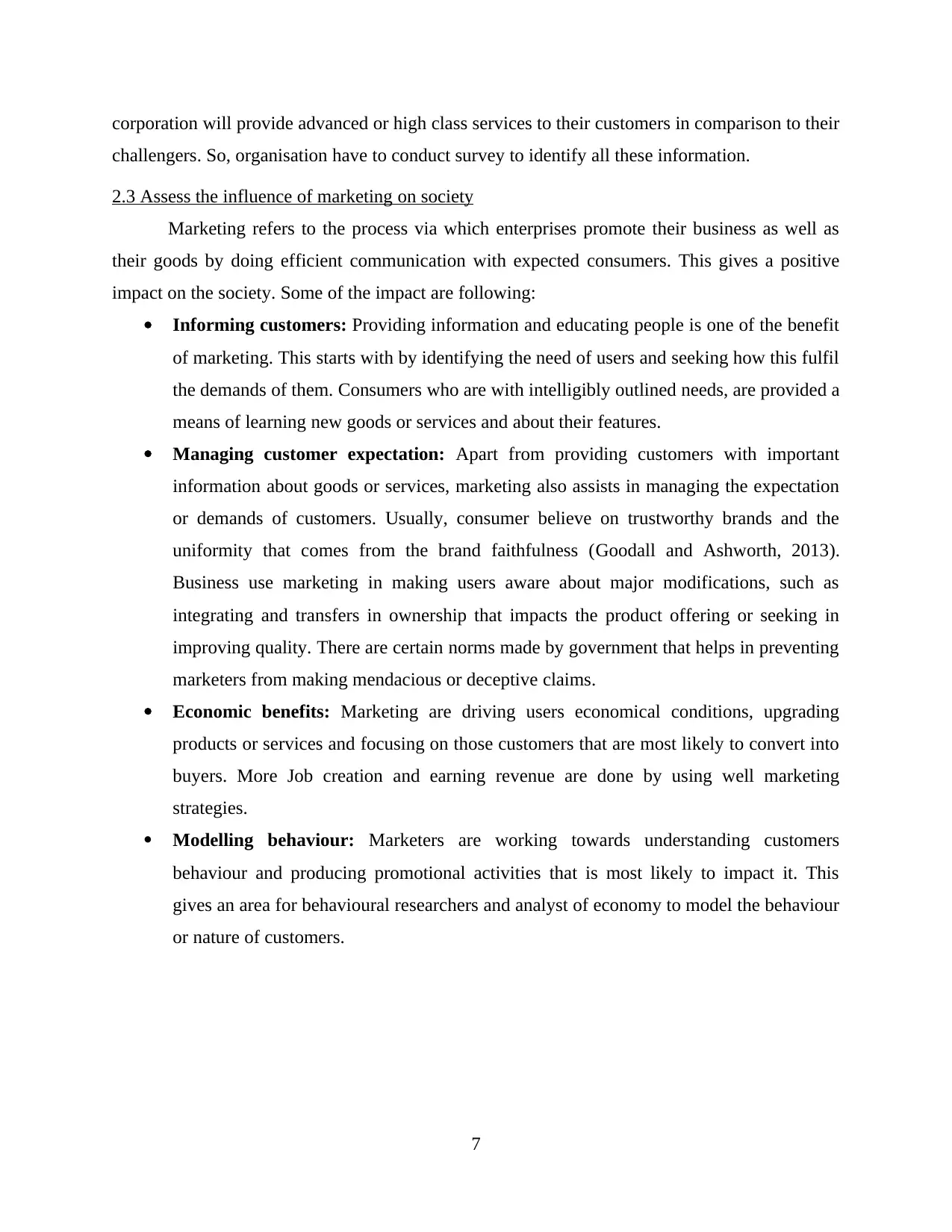
corporation will provide advanced or high class services to their customers in comparison to their
challengers. So, organisation have to conduct survey to identify all these information.
2.3 Assess the influence of marketing on society
Marketing refers to the process via which enterprises promote their business as well as
their goods by doing efficient communication with expected consumers. This gives a positive
impact on the society. Some of the impact are following:
Informing customers: Providing information and educating people is one of the benefit
of marketing. This starts with by identifying the need of users and seeking how this fulfil
the demands of them. Consumers who are with intelligibly outlined needs, are provided a
means of learning new goods or services and about their features.
Managing customer expectation: Apart from providing customers with important
information about goods or services, marketing also assists in managing the expectation
or demands of customers. Usually, consumer believe on trustworthy brands and the
uniformity that comes from the brand faithfulness (Goodall and Ashworth, 2013).
Business use marketing in making users aware about major modifications, such as
integrating and transfers in ownership that impacts the product offering or seeking in
improving quality. There are certain norms made by government that helps in preventing
marketers from making mendacious or deceptive claims.
Economic benefits: Marketing are driving users economical conditions, upgrading
products or services and focusing on those customers that are most likely to convert into
buyers. More Job creation and earning revenue are done by using well marketing
strategies.
Modelling behaviour: Marketers are working towards understanding customers
behaviour and producing promotional activities that is most likely to impact it. This
gives an area for behavioural researchers and analyst of economy to model the behaviour
or nature of customers.
7
challengers. So, organisation have to conduct survey to identify all these information.
2.3 Assess the influence of marketing on society
Marketing refers to the process via which enterprises promote their business as well as
their goods by doing efficient communication with expected consumers. This gives a positive
impact on the society. Some of the impact are following:
Informing customers: Providing information and educating people is one of the benefit
of marketing. This starts with by identifying the need of users and seeking how this fulfil
the demands of them. Consumers who are with intelligibly outlined needs, are provided a
means of learning new goods or services and about their features.
Managing customer expectation: Apart from providing customers with important
information about goods or services, marketing also assists in managing the expectation
or demands of customers. Usually, consumer believe on trustworthy brands and the
uniformity that comes from the brand faithfulness (Goodall and Ashworth, 2013).
Business use marketing in making users aware about major modifications, such as
integrating and transfers in ownership that impacts the product offering or seeking in
improving quality. There are certain norms made by government that helps in preventing
marketers from making mendacious or deceptive claims.
Economic benefits: Marketing are driving users economical conditions, upgrading
products or services and focusing on those customers that are most likely to convert into
buyers. More Job creation and earning revenue are done by using well marketing
strategies.
Modelling behaviour: Marketers are working towards understanding customers
behaviour and producing promotional activities that is most likely to impact it. This
gives an area for behavioural researchers and analyst of economy to model the behaviour
or nature of customers.
7
⊘ This is a preview!⊘
Do you want full access?
Subscribe today to unlock all pages.

Trusted by 1+ million students worldwide
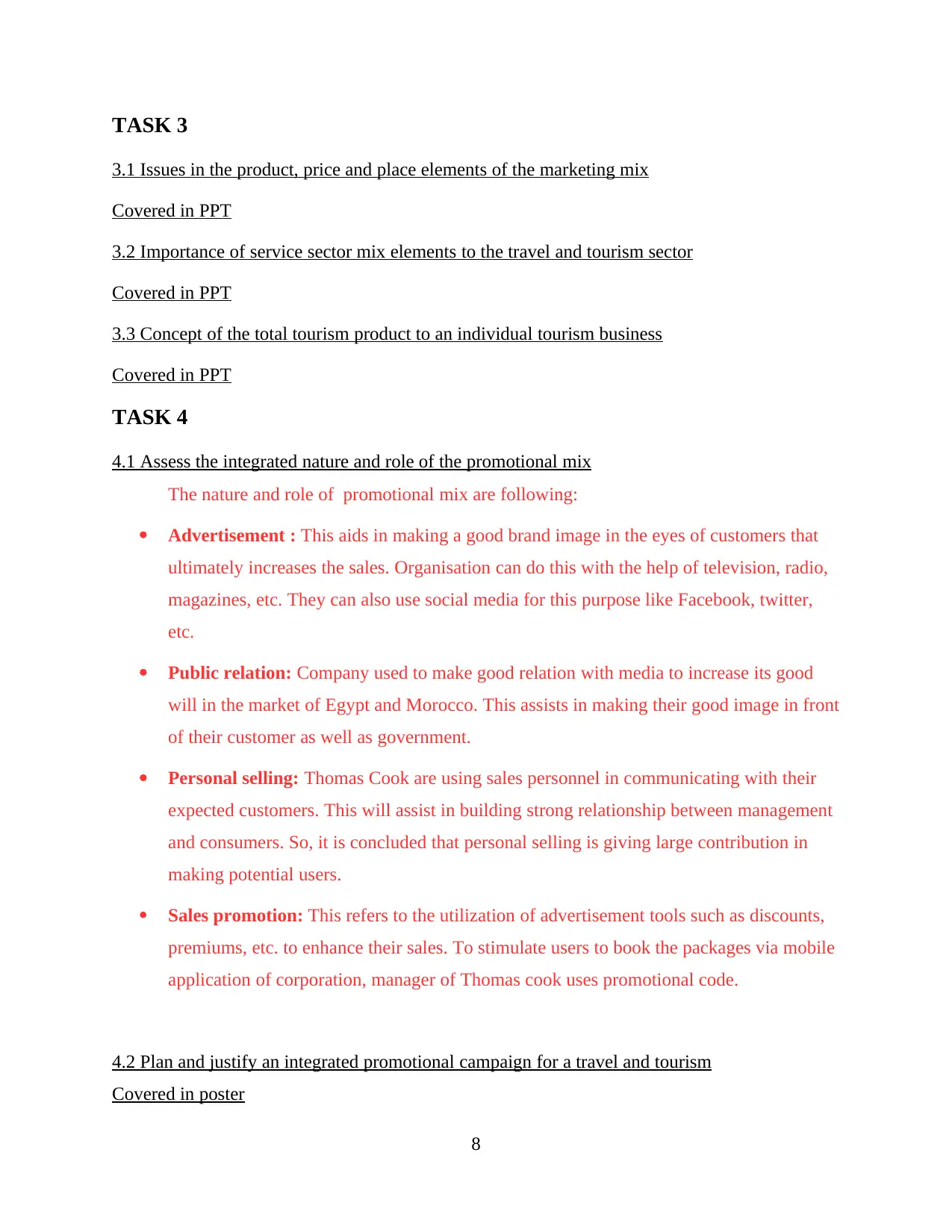
TASK 3
3.1 Issues in the product, price and place elements of the marketing mix
Covered in PPT
3.2 Importance of service sector mix elements to the travel and tourism sector
Covered in PPT
3.3 Concept of the total tourism product to an individual tourism business
Covered in PPT
TASK 4
4.1 Assess the integrated nature and role of the promotional mix
The nature and role of promotional mix are following:
Advertisement : This aids in making a good brand image in the eyes of customers that
ultimately increases the sales. Organisation can do this with the help of television, radio,
magazines, etc. They can also use social media for this purpose like Facebook, twitter,
etc.
Public relation: Company used to make good relation with media to increase its good
will in the market of Egypt and Morocco. This assists in making their good image in front
of their customer as well as government.
Personal selling: Thomas Cook are using sales personnel in communicating with their
expected customers. This will assist in building strong relationship between management
and consumers. So, it is concluded that personal selling is giving large contribution in
making potential users.
Sales promotion: This refers to the utilization of advertisement tools such as discounts,
premiums, etc. to enhance their sales. To stimulate users to book the packages via mobile
application of corporation, manager of Thomas cook uses promotional code.
4.2 Plan and justify an integrated promotional campaign for a travel and tourism
Covered in poster
8
3.1 Issues in the product, price and place elements of the marketing mix
Covered in PPT
3.2 Importance of service sector mix elements to the travel and tourism sector
Covered in PPT
3.3 Concept of the total tourism product to an individual tourism business
Covered in PPT
TASK 4
4.1 Assess the integrated nature and role of the promotional mix
The nature and role of promotional mix are following:
Advertisement : This aids in making a good brand image in the eyes of customers that
ultimately increases the sales. Organisation can do this with the help of television, radio,
magazines, etc. They can also use social media for this purpose like Facebook, twitter,
etc.
Public relation: Company used to make good relation with media to increase its good
will in the market of Egypt and Morocco. This assists in making their good image in front
of their customer as well as government.
Personal selling: Thomas Cook are using sales personnel in communicating with their
expected customers. This will assist in building strong relationship between management
and consumers. So, it is concluded that personal selling is giving large contribution in
making potential users.
Sales promotion: This refers to the utilization of advertisement tools such as discounts,
premiums, etc. to enhance their sales. To stimulate users to book the packages via mobile
application of corporation, manager of Thomas cook uses promotional code.
4.2 Plan and justify an integrated promotional campaign for a travel and tourism
Covered in poster
8
Paraphrase This Document
Need a fresh take? Get an instant paraphrase of this document with our AI Paraphraser
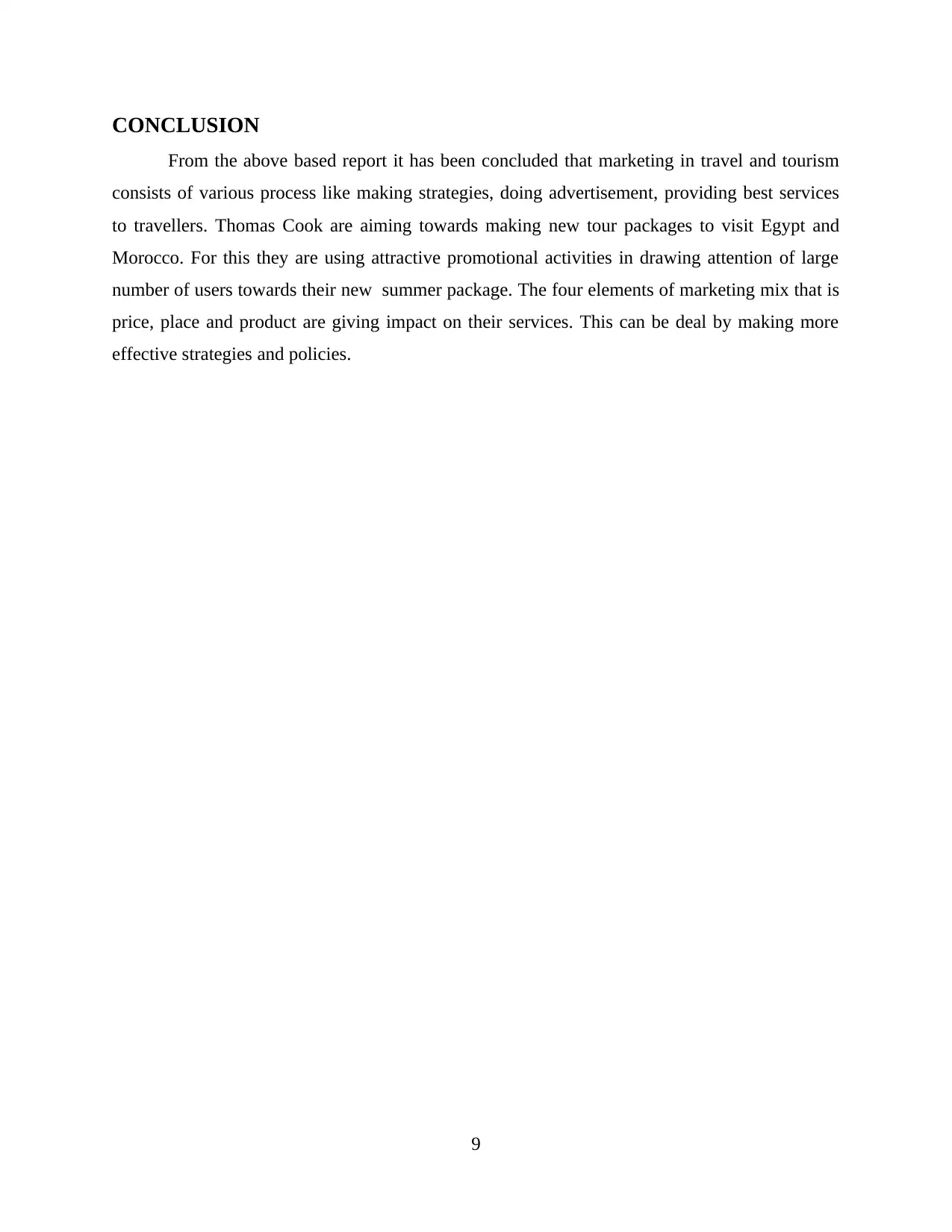
CONCLUSION
From the above based report it has been concluded that marketing in travel and tourism
consists of various process like making strategies, doing advertisement, providing best services
to travellers. Thomas Cook are aiming towards making new tour packages to visit Egypt and
Morocco. For this they are using attractive promotional activities in drawing attention of large
number of users towards their new summer package. The four elements of marketing mix that is
price, place and product are giving impact on their services. This can be deal by making more
effective strategies and policies.
9
From the above based report it has been concluded that marketing in travel and tourism
consists of various process like making strategies, doing advertisement, providing best services
to travellers. Thomas Cook are aiming towards making new tour packages to visit Egypt and
Morocco. For this they are using attractive promotional activities in drawing attention of large
number of users towards their new summer package. The four elements of marketing mix that is
price, place and product are giving impact on their services. This can be deal by making more
effective strategies and policies.
9
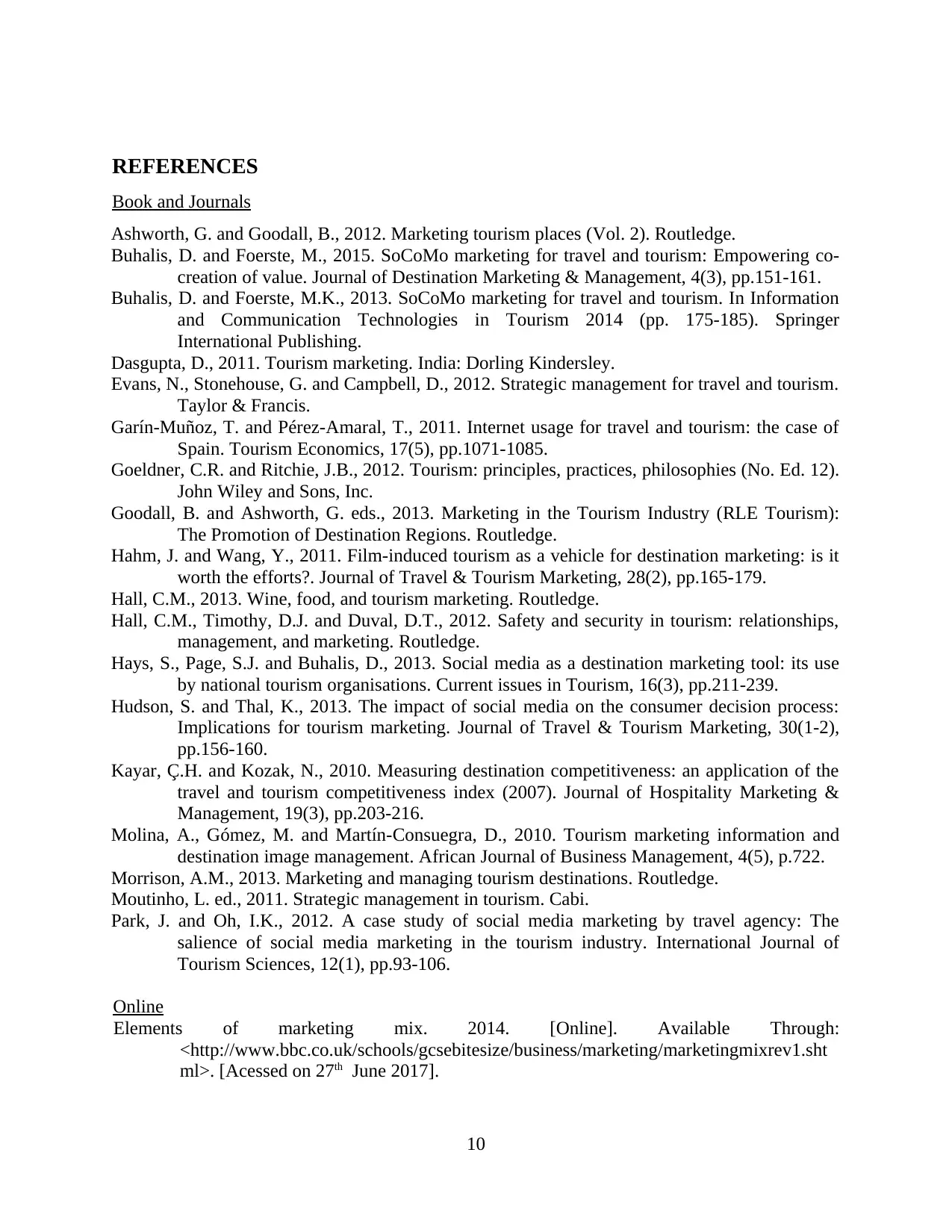
REFERENCES
Book and Journals
Ashworth, G. and Goodall, B., 2012. Marketing tourism places (Vol. 2). Routledge.
Buhalis, D. and Foerste, M., 2015. SoCoMo marketing for travel and tourism: Empowering co-
creation of value. Journal of Destination Marketing & Management, 4(3), pp.151-161.
Buhalis, D. and Foerste, M.K., 2013. SoCoMo marketing for travel and tourism. In Information
and Communication Technologies in Tourism 2014 (pp. 175-185). Springer
International Publishing.
Dasgupta, D., 2011. Tourism marketing. India: Dorling Kindersley.
Evans, N., Stonehouse, G. and Campbell, D., 2012. Strategic management for travel and tourism.
Taylor & Francis.
Garín-Muñoz, T. and Pérez-Amaral, T., 2011. Internet usage for travel and tourism: the case of
Spain. Tourism Economics, 17(5), pp.1071-1085.
Goeldner, C.R. and Ritchie, J.B., 2012. Tourism: principles, practices, philosophies (No. Ed. 12).
John Wiley and Sons, Inc.
Goodall, B. and Ashworth, G. eds., 2013. Marketing in the Tourism Industry (RLE Tourism):
The Promotion of Destination Regions. Routledge.
Hahm, J. and Wang, Y., 2011. Film-induced tourism as a vehicle for destination marketing: is it
worth the efforts?. Journal of Travel & Tourism Marketing, 28(2), pp.165-179.
Hall, C.M., 2013. Wine, food, and tourism marketing. Routledge.
Hall, C.M., Timothy, D.J. and Duval, D.T., 2012. Safety and security in tourism: relationships,
management, and marketing. Routledge.
Hays, S., Page, S.J. and Buhalis, D., 2013. Social media as a destination marketing tool: its use
by national tourism organisations. Current issues in Tourism, 16(3), pp.211-239.
Hudson, S. and Thal, K., 2013. The impact of social media on the consumer decision process:
Implications for tourism marketing. Journal of Travel & Tourism Marketing, 30(1-2),
pp.156-160.
Kayar, Ç.H. and Kozak, N., 2010. Measuring destination competitiveness: an application of the
travel and tourism competitiveness index (2007). Journal of Hospitality Marketing &
Management, 19(3), pp.203-216.
Molina, A., Gómez, M. and Martín-Consuegra, D., 2010. Tourism marketing information and
destination image management. African Journal of Business Management, 4(5), p.722.
Morrison, A.M., 2013. Marketing and managing tourism destinations. Routledge.
Moutinho, L. ed., 2011. Strategic management in tourism. Cabi.
Park, J. and Oh, I.K., 2012. A case study of social media marketing by travel agency: The
salience of social media marketing in the tourism industry. International Journal of
Tourism Sciences, 12(1), pp.93-106.
Online
Elements of marketing mix. 2014. [Online]. Available Through:
<http://www.bbc.co.uk/schools/gcsebitesize/business/marketing/marketingmixrev1.sht
ml>. [Acessed on 27th June 2017].
10
Book and Journals
Ashworth, G. and Goodall, B., 2012. Marketing tourism places (Vol. 2). Routledge.
Buhalis, D. and Foerste, M., 2015. SoCoMo marketing for travel and tourism: Empowering co-
creation of value. Journal of Destination Marketing & Management, 4(3), pp.151-161.
Buhalis, D. and Foerste, M.K., 2013. SoCoMo marketing for travel and tourism. In Information
and Communication Technologies in Tourism 2014 (pp. 175-185). Springer
International Publishing.
Dasgupta, D., 2011. Tourism marketing. India: Dorling Kindersley.
Evans, N., Stonehouse, G. and Campbell, D., 2012. Strategic management for travel and tourism.
Taylor & Francis.
Garín-Muñoz, T. and Pérez-Amaral, T., 2011. Internet usage for travel and tourism: the case of
Spain. Tourism Economics, 17(5), pp.1071-1085.
Goeldner, C.R. and Ritchie, J.B., 2012. Tourism: principles, practices, philosophies (No. Ed. 12).
John Wiley and Sons, Inc.
Goodall, B. and Ashworth, G. eds., 2013. Marketing in the Tourism Industry (RLE Tourism):
The Promotion of Destination Regions. Routledge.
Hahm, J. and Wang, Y., 2011. Film-induced tourism as a vehicle for destination marketing: is it
worth the efforts?. Journal of Travel & Tourism Marketing, 28(2), pp.165-179.
Hall, C.M., 2013. Wine, food, and tourism marketing. Routledge.
Hall, C.M., Timothy, D.J. and Duval, D.T., 2012. Safety and security in tourism: relationships,
management, and marketing. Routledge.
Hays, S., Page, S.J. and Buhalis, D., 2013. Social media as a destination marketing tool: its use
by national tourism organisations. Current issues in Tourism, 16(3), pp.211-239.
Hudson, S. and Thal, K., 2013. The impact of social media on the consumer decision process:
Implications for tourism marketing. Journal of Travel & Tourism Marketing, 30(1-2),
pp.156-160.
Kayar, Ç.H. and Kozak, N., 2010. Measuring destination competitiveness: an application of the
travel and tourism competitiveness index (2007). Journal of Hospitality Marketing &
Management, 19(3), pp.203-216.
Molina, A., Gómez, M. and Martín-Consuegra, D., 2010. Tourism marketing information and
destination image management. African Journal of Business Management, 4(5), p.722.
Morrison, A.M., 2013. Marketing and managing tourism destinations. Routledge.
Moutinho, L. ed., 2011. Strategic management in tourism. Cabi.
Park, J. and Oh, I.K., 2012. A case study of social media marketing by travel agency: The
salience of social media marketing in the tourism industry. International Journal of
Tourism Sciences, 12(1), pp.93-106.
Online
Elements of marketing mix. 2014. [Online]. Available Through:
<http://www.bbc.co.uk/schools/gcsebitesize/business/marketing/marketingmixrev1.sht
ml>. [Acessed on 27th June 2017].
10
⊘ This is a preview!⊘
Do you want full access?
Subscribe today to unlock all pages.

Trusted by 1+ million students worldwide
1 out of 13
Related Documents
Your All-in-One AI-Powered Toolkit for Academic Success.
+13062052269
info@desklib.com
Available 24*7 on WhatsApp / Email
![[object Object]](/_next/static/media/star-bottom.7253800d.svg)
Unlock your academic potential
Copyright © 2020–2025 A2Z Services. All Rights Reserved. Developed and managed by ZUCOL.





